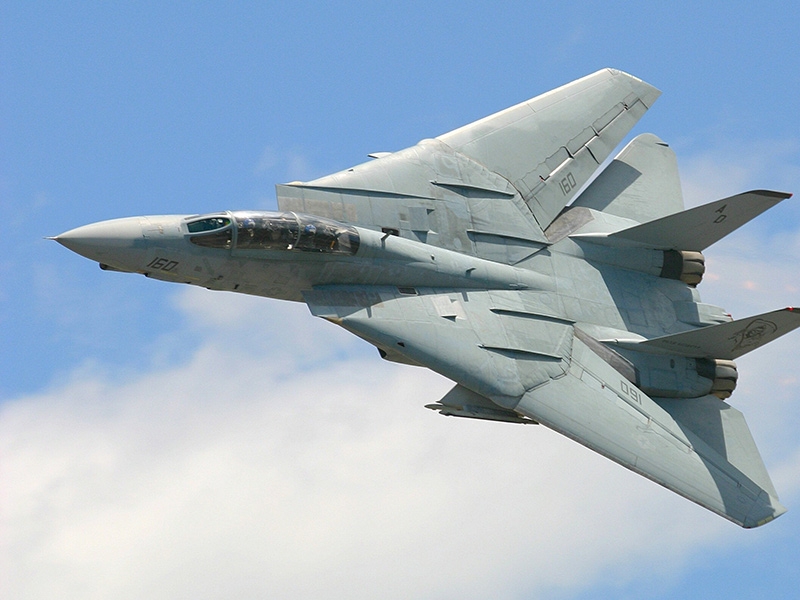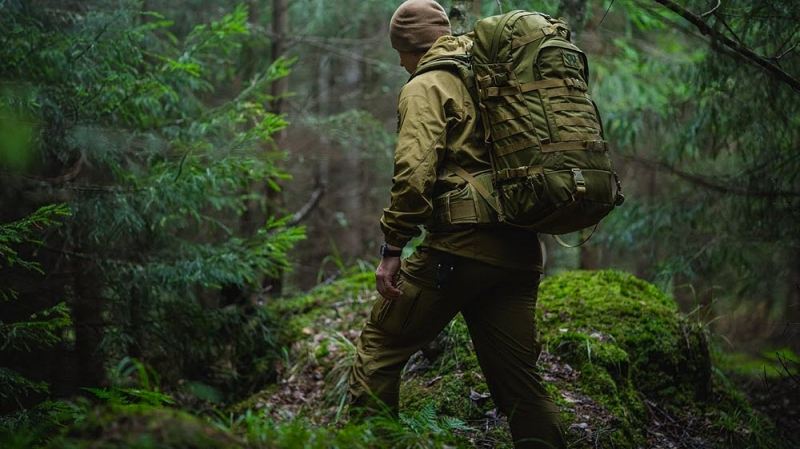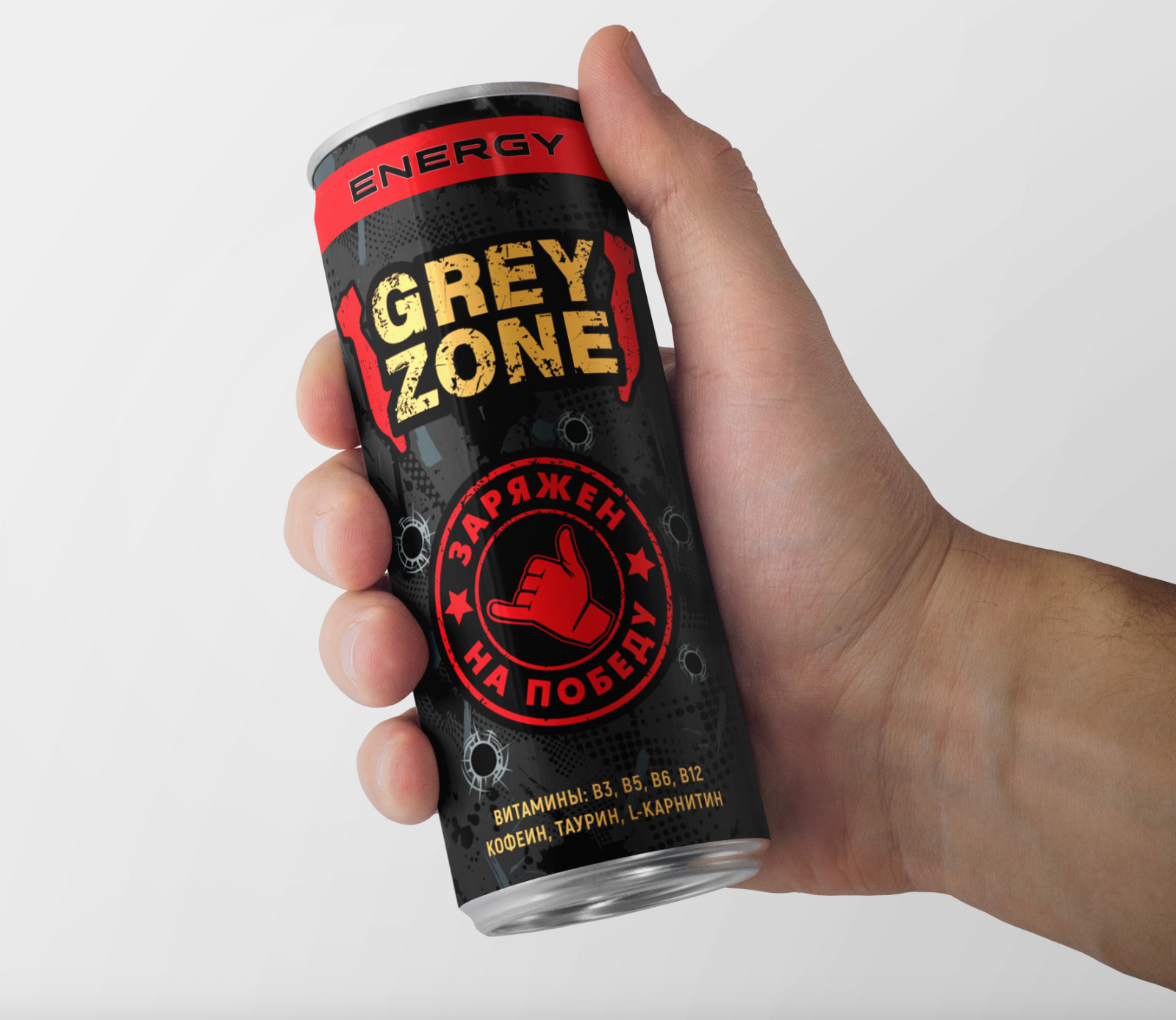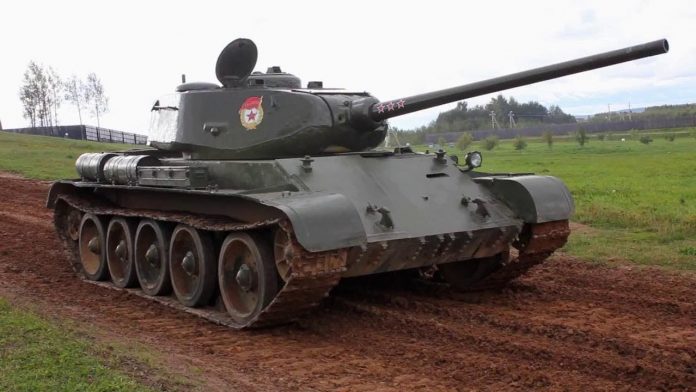
T-44 is not produced in such an amount, how BT, not passed the entire war, like the legendary "Thirty", He did not become the basis for post-war armored troops, as the T-54/55, but, undoubtedly, played a significant role in the development of domestic and world of tank.
TO 1942 by fire and armor superiority, which had Soviet tanks over German in the beginning of the war has come to naught. The Germans actively used new ammunition, tank and anti-tank guns, there were still modernizing average, and finally heavy "Tigers". In addition, from the front began to come and other disturbing news. From parts denounced, that the flexibility and mobility of Soviet tanks has fallen markedly, and their maximum speed admitted inadequate.
Because there were also pieces and assembly complaints of low quality, frequent accidents and damage to tanks. I must admit, that the grounds for this were.
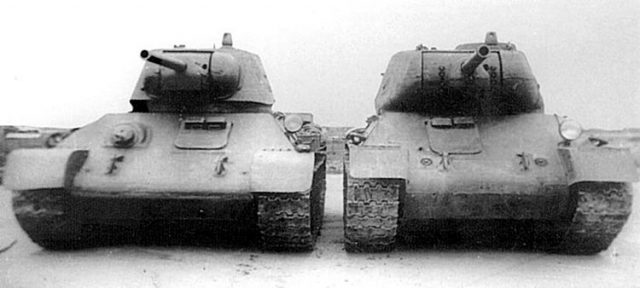 Experienced T-43/76 (case) and T-34/76 (left) with cast hexagonal tower. Attention is drawn to the common forms of housing, the absence of a course machine gun ball mount and identical hatches of the driver (in T-43/76, transferred to the left side sheet lobogo)
Experienced T-43/76 (case) and T-34/76 (left) with cast hexagonal tower. Attention is drawn to the common forms of housing, the absence of a course machine gun ball mount and identical hatches of the driver (in T-43/76, transferred to the left side sheet lobogo)
The fight for the number of
If before the war the issue of medium tanks T-34 was conducted in the well-equipped factories in Kharkov and №183 STZ in Stalingrad, the evacuation of the Urals, the loss of many factories supplying component parts and materials have created enormous difficulties for the qualitative production of tanks. Nevertheless, educated guide 12 September 1941 of the year, in accordance with the decision of the State Defense Committee (LOQ), People's Commissariat of the Tank Industry (NKTP) demand increase in the number of produced tanks.
The designers of the Kharkov tank KB-520 (its leader after the death in Koshkin 1940 he became Morozov), evacuated together with the plant №183, They were sent to fight the improvement of production technology of the T-34, for the savings of non-ferrous metals, rubber, steel armor, and even electric wires. This work took all the power of a small group, It has a membership of only 130 constructors.
Naturally, that in such harsh conditions of the struggle for the amount of, quality of the tanks inevitably decline, acutely manifested and the inherent "Thirty" flaws - inadequate transmission (speed changes is very difficult - because such an effort, Require to switch from second to third gear, was more than 30 kg), The low reliability of the engine-2 (resource wartime issue of diesel was less than initially 100 hours).
Also, in December 1941 , the military demanded that significantly enhance the armor protection of the T-34 with a minimal increase of its mass. Thickening of the armor was to increase the security of the tank from the defeat of new ammunition, appeared on the arms of the German Army. Given the requirements of the military, Morozov commissioned a group of designers to carry out a project to develop an improved "Thirty".
The project is based on the following provisions were laid: while maintaining the basic mechanisms and components of the T-34 and the limitation of the weight of the machine 35 tons, dramatically increase the thickness of armor - with 45 mm 75 mm (due to more dense layout and the rejection of the fourth member of the crew). He planned to implement a reserve Design, KB acquired more in 1940 year in the development of the T-34M.
In the pre-war draft of the T-34M provided significantly enhanced armor protection body and bringing it to tower 75 mm 90 mm, respectively,. To compensate for the increased weight of the armor was radically redesigned chassis — They abandoned the heavy and cumbersome McPherson suspension (was taken over by T-34 inherited from another tank Christie and BT). Instead, the torsion bar suspension has been adopted, with lightweight road wheels of small diameter with internal shock absorption.
Reduced by one person and crew (abandoned loader). At the end 1940 year at the Zhdanov plant were even made armor plates for five sets of casings T-34M. However, a large amount of work to prepare the mass production of "Thirty" has led to, that work on the T-34M has been suspended.
improved T-34 project was presented in February NKTP 1942 of the year, but it was not approved. The heavy military situation at that period of the People's Commissariat management found, that deal with the new machine is not yet time, and CB-520 is instructed to continue to work to improve the design and production technology serial T34.
The new tank T-43
By the project of a new tank back in the second half 1942 of the year. The legend says, that one day called A. Morozov himself Supreme Commander - Joseph Stalin, and in his characteristic manner announced: «have an opinion, that it is now time to start work on the new tanks», and urged Designer. According to the leader of all people it was taken to be treated as orders, and accordingly work started with renewed vigor.
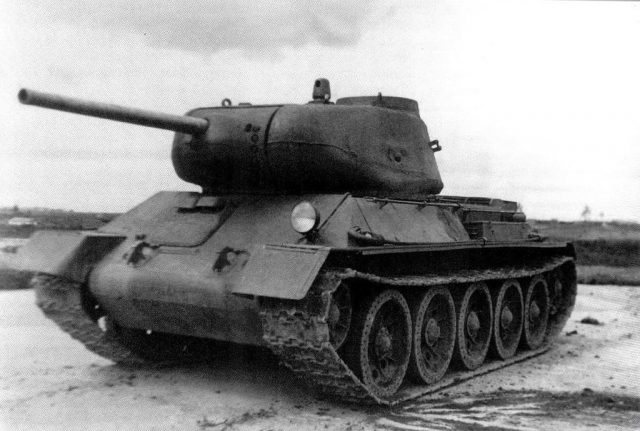 Experienced T-43 with 75 mm cannon. Visible Undercarriage, borrowed from T-34, triple cast turret with an extended shoulder straps and low-profile commander's cupola
Experienced T-43 with 75 mm cannon. Visible Undercarriage, borrowed from T-34, triple cast turret with an extended shoulder straps and low-profile commander's cupola
The new tank, received index T-43, basically kept the body shape, engine, transmission and gun his predecessor. With the "Thirty" it was unified to 80% parts. The main difference lies in the strong reservations. The thickness of the body armor parts made 75 mm, and the tower - to 90 mm.
The housing design has been simplified to improve the conditions of automatic welding. With the front plate removed exchange machine gun ball mount, and the driver's hatch moved to the right side. Left, in the bow of the hull, in armor vыhorodke, We placed the fuel tank (Side tanks of fenders removed).
To ensure that the crew needed interior space and save weight, designers, for the first time on an average tank, applied torsion suspension rollers. She was much more compact and lightweight than, candle with vertical springs. Tank got a new larger three-local cast turret with commander's cupola and the diameter of the ring 1600 mm.
Motor-transmissionnoe compartment (MTO) It remained virtually unchanged — engine and transmission installed the same, how and T-34, except for the new 5-speed gearboxes (PPC). However, due to the increased weight, maximum speed and reduced permeability.
As a result, T-43 had a combat weight 34,1 t, F-34 gun caliber 76 mm, two machine guns DT, The motor-type power 2 500 hp, specific power 14,65 hp / ton, armor - 75 mm (disposed at angles 54 degrees 52 degrees), the crew of four people, maximum speed — 48,3 km / h.
Since March 1943 , the prototype T-43 passed various tests, including front-line (in the "special tank company 100 ') and probegovye (on 3000 km). Tower, as the most complicated knot new tank tested, also using two "riding laboratories" — modified to install the tower T-43 hulls "tridtsatchetverok".
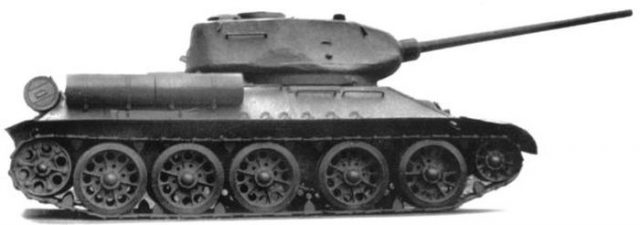 Middle T-34 tool 85 mm — T-34/85
Middle T-34 tool 85 mm — T-34/85
Around the same time, (February March 1943 of the year) turned feverish activity rearmament of Soviet tanks with more powerful artillery systems, initiated by the disappointing results of test firings, captured Tikhvin on the front of the new German heavy tank PzKpfw VI «Tiger». his armor (thickness 100 mm) It did not break available by the Red Army tank and anti-tank guns. To improve the situation was an attempt to install the tower T-43 guns D-5T-caliber 85 mm, when sharing it not three, and two crew members. However, to do so in strictly allotted time - to 5 July 1943 the year it was not possible (due to the unavailability 85 mm guns).
Nevertheless, 15 July, in the midst of the fighting on the Kursk Bulge, order GKO tank T-43 (reference) It was recommended for adoption by the Soviet Army, wherein before development the 85 mm tank gun with arms of 76 mm gun F-34M!. And the factory №183 began preparations for its serial production. The first ten T-43 was supposed to be released by end of August 1943 of the year, but the production of this series, and in general preparing mass production of T-43 were soon stopped by order of Stalin. What happened?
The thing is, that moving factories to the production of new tank, though who had much in common with the T-34, would inevitably have caused a decline in production volumes, and it is considered unacceptable on the eve of the planned extensive offensive operations. In his memoirs, Stalin Morozov gives this comment about the T-43: «comrade Morozov, You have done a very good machine. But today, we already have a good car - T34. Our challenge is now is not, to make new tanks, and in that, to enhance the quality of fighting T-34, increase their production…».
In addition, there is an urgent need to equip the Soviet tanks more powerful weapon after the Battle of Kursk, than 76 mm cannon. However, if previously only possible candidate for re-medium tank 85 mm gun was T-43, after test "driving laboratories" of the housing T-34 and T-43 tower (powered 1600 mm) It becomes clear, that the T-43 will be a serious competitor. Really, No one can doubt the fact cause, it's easier and faster just to learn a new tower in the series, rather than a tank.
As a result, it has been developed, and T-bills by Decree №5020 23 January 1944 year put into service a modified "Thirty" — T-34/85 with 85-mm cannon caliber, and from the production of T-43, as mentioned above, refused. Nevertheless, experimental work on the T-43 continued for some time — so in 1944 he was still built another prototype T-43 with enhanced weapons - 85-mm gun D-5 in the new tower.
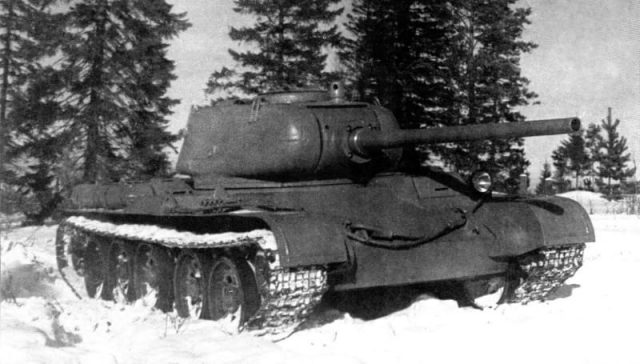 Experienced T-44 with 85 mm gun D-5T.
Experienced T-44 with 85 mm gun D-5T.
After the failure of the project T-43, which is essentially deep modernization T34, A. Morozov became clear, that the new design of the machine must have considerable reserves for further development, as the basis for creating a better tank may be to improve its layout.
A. Morozov considered, which significantly increase the space crew compartment may be due to refusal of placing the engine and transmission at the rear of the new tank, or more dense layout engine unit and the department as a whole. in the spring 1943 the group MTO-520 KB proposed layout tank circuit T-seal 34 by placing the motor across the power pack (in fairness, need to mark, such that the motor arrangement version was proposed in Koshkin 1940 year for the T-34M).
Creating a new tank is actively supported by the People's Commissar in NKTP. Malyshev, by which the order was opened for its construction, but also established and fairly rigid terms of readiness to Factory range tests (they were to be held no later than 10 January 1944 of the year).
Designing a new tank designers do Volkov, M.Kizin, M.Nabutovskyy, M.Tarshynov, N.Chistyakov under the direct supervision of A. Morozov. Tank got Index T-44 and designed for the installation of the caliber cannons 85 to 122 mm. Morozov has repeatedly stressed, that the T-44 should be a completely new type of machine, by mass since it had to stay medium, and armament and booking - meet the heavy tanks of the time.
The new machine is applicable not only transverse engine, but also a number of other technical innovations, are being implanted separately, on different tanks, would not give a tangible effect, but collectively have made design of such a T-44, which for decades has determined the development of Russian armored vehicles.
The first prototype T-44 was prepared ahead of time - to 1 January 1944 of the year. His trials were also held in January and generally ended successfully. During the period of the test tank was no more serious damage 1100 km. The shelling of its armored hull of the captured German anti-tank guns Cancer 40, caliber 75 mm, showed, that its front part is not making its way to more distances 300 m, and from distances more 700 m and 88 mm projectiles guns tank PzKpfw VI «Tiger". Nevertheless, it was decided to increase the thickness of the boards before armor 75 mm, and the tower - to 90 mm.
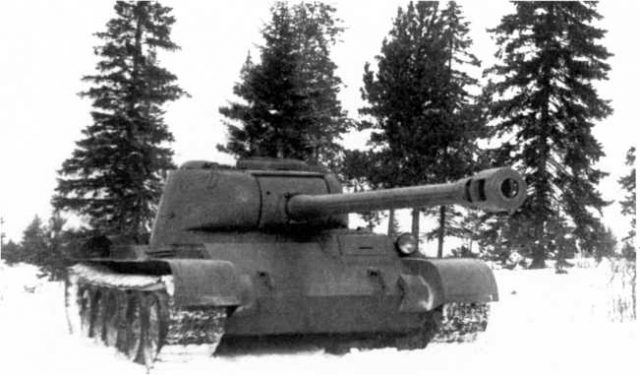 Experienced T-44 with 122-mm D-25 gun turret with increased. Visible to the pinnacle of the driver
Experienced T-44 with 122-mm D-25 gun turret with increased. Visible to the pinnacle of the driver
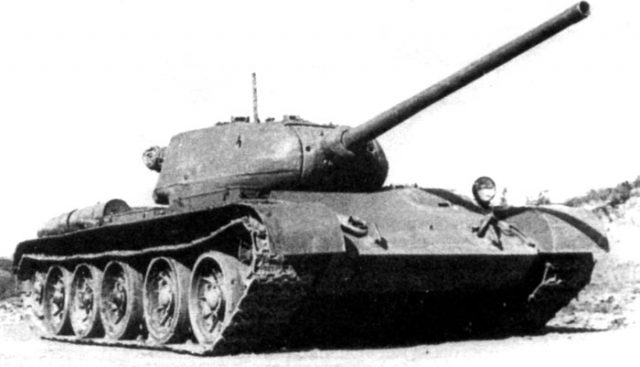 Experienced T-44 with 85 mm gun D-5T
Experienced T-44 with 85 mm gun D-5T
In February 1944 two years experienced the T-44 were made, armed respectively 85 mm gun D-5T and 122 mm gun D-25T-44 (with tanks 85 mm gun were to become conventional - "linear", and 122 mm cannon - tanks, artillery strengthening), which differed, the size and configuration of towers. They were tested in conjunction with the T-34 and captured tank PzKpfw V «Panther" in February-March 1944 year and once again demonstrated the reliability of their mechanisms and assemblies.
T-44 was easier to both said samples, but its armor protection in the frontal part was not worse than that of the "Panther", which was rather heavy tank, while in Germany and was considered average. In this case, the T-44 weapons corresponded to the level of the Soviet heavy tank IS and the German "Tiger", and could be in the future even enhanced by the new tower.
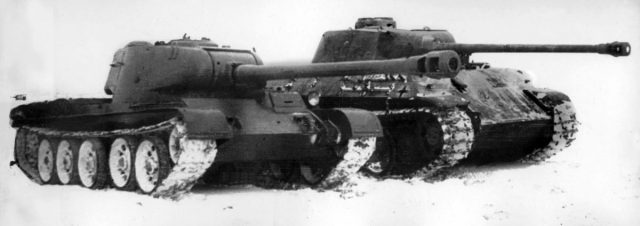 The T-44-122-V and T «Pantera» on the comparative tests
The T-44-122-V and T «Pantera» on the comparative tests
The width of the T-44 hull has been selected on the basis of the installation of the tower with the terms of service 1800 mm, length was almost the same length T-34 casing, and the height was reduced as much as possible and was only 830 mm in front of and 965 mm aft. The upper front body sheet arranged at an angle 60 degrees. Abandoned bulky nadgusenichnyh niches — the side wall of the housing by vertical steel.
As a result, the shift tower turret back to make room for the sheet-manway hatch of the driver, where he was placed. In this way, the driver has an excellent view in the position "in its stowed", respectively, and improved manageability. Along the way, get rid of the entanglement of the driver when driving on water ford, as it was at T 34 (to improve visibility of the driver T-34 had generally perform marches with open hatch).
On the first prototype rectangular turret in the front has been made over the driver's place, which had a manhole-plug. but later, on production machines, it was abandoned, and mechanics left only a small observation slit in the frontal, closed triplex, and on the roof of the shell - periscope.
Crew expelled arrow-radio operator, since due to poor review of the shooting machine gun course was ineffective, and radio communications transmission through reduced crew member communication efficiency. radio operator functions have been transferred to the commander, and in place of the radio operator put the fuel tank and placed the ammunition for guns. Accordingly disappeared and course gun ball mount. true, apart tanks T-44 release after 1945 year exchange machine gun was mounted again, but rigidly fixed in the frontal, the right of the driver, that led from his unsighted fire.
As I mentioned above, to increase the volume of the crew compartment and ensure the possibility of installing a tower with a diameter of up to overhead 1800 mm (against 1580 mm at T-34/85), MTO has been significantly reduced length (by installation of the motor housing across — parallel PPC, as well as a more rational and dense placement of its units).
It is possible to obtain the size of the crew compartment, allowing for the possibility of setting it up to the caliber of weapons 122 mm inclusive, as well as shift the tower back, so that its axis of rotation is almost coincided with the center of the housing. Here the angular fluctuations of the machine were the smallest. As a result of increased accuracy from a tank gun and reduced crew fatigue. Less has been and likely utykaniya long stem in the ground when driving on rough terrain (military general periodically demanded by designers, that the gun does not go beyond the body dimensions).
Most of the combat pack - 44 shot, located in a special rack, right in front of the body. Yet 16 shot was taken in the tower (12 - in the rear recess, 4 - on the right side), and the last five on the left side of the body. Machine gun wheels also were in the housing.
122 mm gun D-25T-44, Mounted on the T-44, significantly different from the conventional D-25-T, which had a separate loading (projectile and the propellant charge has been charged separately). At first, on the D-25T-44 was somewhat reduced barrel length, Secondly, special unitary shot has been developed for it with decreased approximately 3% powder charge. anticipated, it will increase the rate of fire guns in the tank.
The first tests of the T-44 with 122 mm gun took place in February and March 1944 of the year, but ended unsuccessfully: gun out of order, and it was returned to the factory. In April trial resumed, but it turned out, that the rate of increase can not be achieved at the expense of a unitary loading. conversely, large mass and size of the unitary shot greatly complicated the work of the crew. charge the gun, because of its low and insufficient fit "adjustable length" even with the tower overhead product in 1800 mm, It was very difficult. In the case of separate loading rate was only 1 rds. / min. Also, of ammunition 24 122-mm rounds unit was totally inadequate for the middle of the tank and the tasks, which were placed before him.
Planned for installation on T-44 engine power B 2-44 520 HP. (modified diesel V-2IS), apparatus equipped with improved fuel. Water and oil radiators placed horizontally, under the roof of the MTO, in a uniform air stream. Roof MTO turning on its hinges with radiators, opening as a good access to the engine and its equipment, and to all elements of the transmission. the motor is powered by three fuel tanks total capacity 420 l, located in special compartments of motor septum.
Height MTO further reduced, moving the air cleaner (a new type) disintegration of the engine to the board. The fan, T-34 advocated crankcase dimensions, We put a compact flywheel. This made it possible to mount the engine on low, tough, but light motor frame. As a result, the height of the housing, compared to T-34/85, decreased by 300 mm.
Mechanical power transmission, It consisted of a guitar, main friction, five-speed gearshift, steering clutches with band brakes and final drives. Except for the guitar and CPR all units have the same, How T-34.
Chassis torsion bar suspension had already tested on the T-43, but the tracks of the new machine are the same, How T-34, By the way, "sorokchetverka" became the last Soviet medium tank with caterpillars engagement ridge.
As mentioned, as a result of tests carried out revealed, that the gun 122 mm caliber for the T-44 for a number of reasons not suitable. Therefore, after the third prototype of T-44 was rearmed gun ZIS-S-53 85 mm caliber, adopted for the T-34/85 (instead 122 mm gun D-25-44) and, receiving an improved powertrain, successfully tested in March 1944 of the year.
In June 1944 year were made following two copies of T-44 (reference) In the engine-2-34M and ZIS-S-53, which basically repeated construction machines February, slightly differs from them in some detail. And by August 1944 I have been willing to "improve" the T-44A. The new tank was tselnolitye tower with "enhanced" protection (thick forehead 110 mm, board - 80 mm), frontal armor hull, dovedennuyu to 90 mm and a planetary transmission.
T-44 production was planned to establish liberated 23 August 1943 year Kharkov, the territory KhPZ, who had relatively minor damage and that, according SCTB, It may be restored as soon as possible. In accordance with the Resolution of the GKO, there was organized a tank factory №75 with the release of the task before 300 T-44 in a month. Evacuated from Kharkov plant №183 in Nizhny Tagil continued well-established production of T-34/85. To this end, the territory KhPZ reevakuirovalsya from Kirov factory number 38, equipment and personnel, including existing there CB, under the leadership of the founder of self-propelled gun SU-76 M.Schukina.
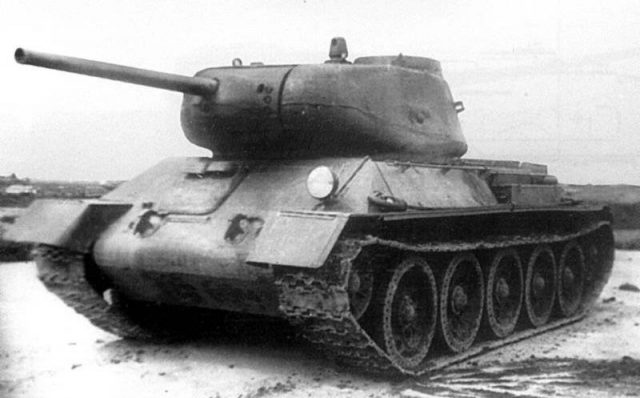 Serial tank T-44. Clearly visible differences from the prototype — smooth front sheet with a small observation slit of the driver, ZIS-S-53 in the new mask, another form of the tower. Clearly visible round driver's hatch on the turret piece, caterpillars and rollers — similar to T-34.
Serial tank T-44. Clearly visible differences from the prototype — smooth front sheet with a small observation slit of the driver, ZIS-S-53 in the new mask, another form of the tower. Clearly visible round driver's hatch on the turret piece, caterpillars and rollers — similar to T-34.
In September in Kharkov started work on the assembly of the first production T-44A. Production tank nodes conducted on site, but the hull and turret do to UVZ, and diesel CHKZ, which naturally causes a constant delay. In November 1944 Year of the shops of the Kharkov plant, out the first five T-44A, and in December more 20, which were sent to the Tank School. At first 1945 , the production of T-44A, ongoing in Kharkiv under the name "T-44 of the first series of", It managed mainly to debug and it went at an increasing rate.
Meanwhile Morozov in Nizhny Tagil continued to improve the T-44. To increase snaryadostoykosti frontal sheet body was eliminated altogether projecting turret driver, at the same time changes were made in the technology of its manufacture.
experienced tank, named T-44b, It was over 20 November 1944 of the year. Furthermore monolithic front sheet, he got reinforced bottom, new propulsion systems B-2-44 with a cooling system and power supply, and gun ZIS-S-53 with an increased ammunition. Shortly before the new 1945 , the tank was sent to Kubinka (Research and Testing Armored landfill), where he successfully passed state tests.
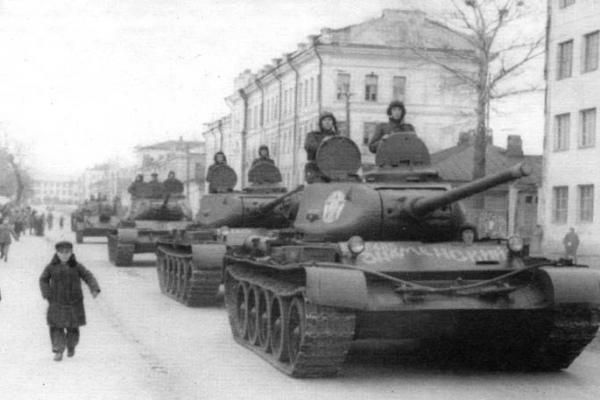 Tank T-44b
Tank T-44b
FROM 1 March in Kharkov started its mass production (T-44 "series of gross" or T-44b). According to the plan before the end of NKTP 1945 the year had to be made 850 T-pieces 44b with a total order in 1200 PC. According to some information before the end of the war already released in Europe 190 machines, but in combat they did not participate, because it still considered "partially fit" (MP, torsion bars, final drives work reliably). Up until the end of May, the T-44 gave up only training units, and in June the first batch of new tanks were shipped to troops, and in August, a tank unit, equipped with new machines, I went to the Far East in the army. However, in the battles they did not participate.
just 1945 year by the number 75 it was made 880 T-44b, but by the end of 1945 it was decided to terminate as the work on the tank, and its serial production. Nevertheless, limited production of the T-44b continued for the entire 1946 year, during which it was collected 718 tanks. In this way, just 1944-1946 Years was released 1631 tank (including 8 №183 experienced factory in Nizhny Tagil).
It was never put into production, and there was only been prepared for the T-44b arms production in test samples 100 mm cannon. The development of this machine has been caused by the advent of the end of the war German tanks and self-propelled guns with a significantly enhanced armor protection. For reliable power to deal with them 85 mm cannon, which were armed with Soviet medium tanks, It has lacked.
AT 1945 year two prototypes of the T-44-100 with a gun were built LB-1 (LB stands for Beria, who at the time was deputy chairman of the State Defense Committee and was in charge of weapons). The sides of the tank and chassis covered steel screens thickness protivokumulyativnymi 6 mm. weight of the tank reached 34 t, ie increased by 3 t compared with the serial T-44. To combat low-flying aircraft installed anti-aircraft machine gun - the ANC on the turret of the loaders hatch. Ammunition gun was 36 shots. Tank tests ran successfully on the whole, although the embarrassing presence of the military on the barrel muzzle brake gun, and reduced maneuverability T 44-100.
As a result, the T-44-100 was not allowed to state tests, and work on it was stopped. This was due not only to the inherent structural deficiencies and the end of hostilities. The main reason was that, what in 1945 year was ready the project of a new medium tank with the same powerful weapons, but superior to the T-44-100 all other parameters. This tank was the future of T-54.
Combat baptism T-44
As mentioned, to Europe, before the war, T-44 did not manage to get there. Therefore, the "battle" baptism T-44 can be regarded as 1956 year, when Soviet troops, equipped with these tanks, It was introduced in Hungary for the "suppression of anti-government insurgency". by the way, Hungary "sorokchetverkam" had to war with his "ancestor of" T-34/85 - the rebels captured five in Budapest "tridtsatchetverok" Hungarian People's Army, who then took part in battles against Soviet forces, entered into the city.
Armed uprising started in Budapest 23 October 1956 of the year. Count on the help of the Hungarian army was not necessary, of 26 thousand. personnel of the Hungarian People's Army half - 12 thousand. supported the rebels. The same evening, the commander of the Special Corps of Soviet troops stationed on Hungarian territory with 1955 of the year, I received an order to nominate Budapest.
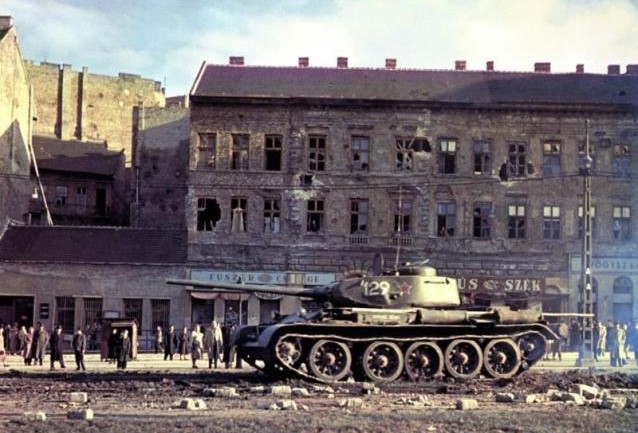 Tank T-44b, Budapest, 1956 g.
Tank T-44b, Budapest, 1956 g.
The first battle on the streets of Budapest joined the 2nd Guards Mechanized Division (Commander Major General Lebedev), lost per day 4 tank and 4 armored. By the end of 24 in October the number of Soviet troops, included in Budapest, no more than one division (about 6 thousand. human, 290 tanks, 120 armored personnel carriers and 156 guns).
but in the morning 25 October came to Budapest 33rd Guards Mechanized Division, thrown from Romania, its membership included the 71 th Guards Tank Regiment, armed tanks T-44. And in the evening the 128-th Guards Rifle Division, which were immediately incorporated into the special housing. By this time, the rebels intensified resistance, which it was associated with the incident, occurred outside the parliament building. Here, a Soviet officer was killed, burned tank.
on the morning 28 October was planned assault on the capital center. but 29 October, Soviet troops were ordered to cease-fire. 31 October, the government and. Nadia demanded the immediate withdrawal of Soviet troops from Budapest. This requirement has been met, and 31 October all Soviet formations and units were concentrated in 15-20 km from the capital.
1 November Hungarian government announced its withdrawal from the Warsaw Pact, as well as the neutrality of the country and the need for the withdrawal of Soviet troops from the country. The reaction was immediate. Top political leadership of the Warsaw Pact decided to provide Hungary "military aid".
4 November 1956 year stormed Budapest - operation codenamed "Whirlwind". By this time, around the capital of Hungary, the rebels have created a defensive belt, reinforced by hundreds of anti-aircraft guns. In settlements, adjacent to the city, there were gates with tanks and artillery. The most important objects of the city were occupied by armed groups, the total number of which reached 50 thousand. human. At the disposal of the rebels were about 100 tanks.
A major role in street fighting in Budapest played 33rd Kherson Red Banner Order of Suvorov twice Guards Mechanized Division (its membership included the 71 th Guards Tank Regiment, armed tanks T-44), where the 100th tank regiment was given to strengthen (armament IS-3). Early morning 4 the main force in November 33rd and 2nd Guards mechanized divisions to go broke in Budapest and the day captured the bridges across the Danube, airfield Budaesh, capturing with almost all the tanks rebels, 15 guns and 22 Aircraft.
Tanks cannon fire and rammed done the passages in the barricades, built on the streets of Budapest, punching passages infantry and airborne troops. The scale of the battles is evidenced by the fact, what 5 November storm the site of resistance in the cinema "Corwin" which involved part of 33th Guards Mechanized Division, It began after the artillery attack, which was attended by 170 guns and mortars. On three sides of several dozen tanks shot surviving emplacements. Only in the evening, Soviet troops captured the quarter. TO 11 November defeat of the armed groups in Csepel and Buda was completed the fighting in Budapest.
About fighting gravity indicates that, that only 33 Guards Mechanized Division lost 14 Tanks and self-propelled guns (maybe one of them were T-44 from the 71 th Guards Tank Regiment), 9 armored vehicles, 13 guns, 4 installing BM-13, 31 car and 5 motorcycles.
After 1956 , the T-44 in combat operations did not participate (anyway, author does not know about it). Later, during the escalation of Sino-Soviet relations, some of them, among others, older tanks was transferred to the Chinese border in the Trans-Baikal region and Central Asia, where they were used for the construction of bunkers.
Generally they served "sorokchetverki" for a long time, survived during this period a few upgrades. FROM 1961 tanks, the T-44 is being upgraded, which was to replace the transmission units and the undercarriage units in tank T-54. They are installed in diesel-power 54 520 hp, Guitars redesigned, new main clutch, five-speed gearbox with synchromesh, allowing to increase the speed of the tank to 57 kmh.
Just as in the T-54, mounted two-stage planetary rotation mechanisms (PMP). The car received a pin engagement tracks, whereby hesitated tracks and driving wheels and guide structure. the housing also, Tower and weapons change almost not undergone, except, that gun ammunition was increased to 61 shot. The driver got a night vision device. But the anti-aircraft machine gun tank had. This upgraded machine received the designation T-44M.
AT 1963 , part of the T-44M has been converted into a command tanks. They were equipped with two radio stations, which led to a reduction of ammunition to 46 shots and the dismantling of guns course. This machine received the designation T-44MK.
The next modernization, conducted in 1966 year, installed on the tank two-plane gun stabilizer, also it increased its stock of progress. This tank was called the T-44C.
It should be noted, what, despite the fundamental technical novelty, according to the memoirs of tankers in its final form "sorokchetverka", according to the degree of reliability, remontoprigodnosti, volume maintenance and service life was similar to its predecessor T-34/85 - "workhorse" tank forces, held the entire Great Patriotic War from start to finish.
After the war, probably for reasons of secrecy, the presence of the Soviet army a new medium tank was not advertised. T-44 did not participate, in the post-war parade (to fear former allies), such as heavy IS-3, not often he found himself on the pages of newspapers and magazines. Nevertheless, it was he, as in his time, and T-34, became a landmark in the development of world tank building and the basis for the development of Soviet machines next baby boomers - the T-54, T-55 and T-62.
/Sergei Shumilin, naukatehnika.com/







